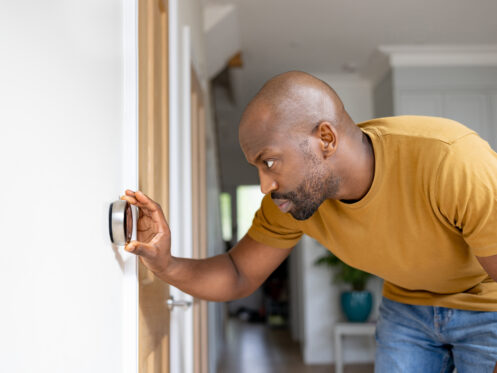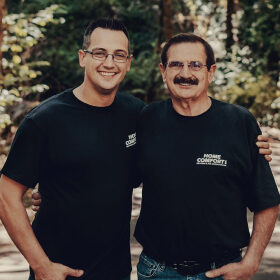The cold winter temperatures in Salem, OR can cause several issues for your home’s plumbing and HVAC systems. You don’t want to be faced with broken pipes or a lack of heat. Luckily, there are some ways you can prevent these scenarios in your residence this winter.
Preventing Frozen Pipes
When water freezes, it will expand. If water inside your pipes freezes, this expansion can lead to pipe damage or your pipes bursting. Not only will this interrupt the normal function of your plumbing system, but it can also cause extensive water damage. Water damage can harm the structural integrity of your home, damage walls, ruin furniture, and even cause mold to grow. If you are exposed to mold in your home, this can lead to dangerous health issues and symptoms like shortness of breath and headaches.
There are steps you can take to prevent frozen pipes when the temperature outside drops extremely low. Some people think you need to deal with sub-zero temperatures outside for your home’s plumbing system to be affected. In fact, an interior temperature of less than 55 degrees Fahrenheit and standing water are often all that’s needed for freezing to occur.
Interior Temperature
Keep your home’s thermostat always set to at least 55 degrees Fahrenheit, even if you’re going to be away from home for an extended period. Consider installing a smart thermostat so you can monitor your HVAC system remotely.
Promote Air Circulation Around Pipes
If there’s a cold snap in your area or you’re going to be leaving your home for several hours, open the cabinets and vanities that have pipes inside them. The purpose of this is to allow warm air to circulate around your pipes so they’re less likely to freeze. If you’re home, you can point a space heater in the direction of these pipes to increase the temperature further.
Install a Hot Water Recirculating Pump
There are devices called hot water recirculating pumps that can be used in homes that are prone to frozen pipes. Hot water will circulate through your plumbing system even when you’re not running any water. This prevents water from freezing.
Address Outdoor Plumbing
Prior to the start of winter, make sure you winterize any outdoor spigots or fixtures. Turn off the main water supply to these areas. Drain them completely so no standing water is left behind. You can also take further steps to prevent outdoor pipes from freezing, including using special insulated fixtures designed for outdoor use or installing insulated covers on the outside of your fixtures. There are also installation choices that can help prevent water from freezing as well, including the use of a freeze-proof faucet.
Leaving Water on a Trickle
You can leave your faucets dripping with a small amount of water to prevent the water inside them from freezing. You don’t want to use this method all winter since it can increase your utility bills, but it’s useful during extreme cold or inclement weather.
Protecting Your HVAC System
Your plumbing system isn’t the only system in your home that can experience issues because of cold weather. You rely heavily on your heating equipment in the winter, which can cause a great deal of strain on your system. This can lead to more frequent repairs and even a decrease in your equipment‘s life expectancy. You can take steps to protect your HVAC system in the winter, ensuring its efficiency and reliability.
Keep Outdoor Vents Clear
Your HVAC system may have a pipe located outside that expels air from your furnace. If this airflow isn’t achieved, your entire system may shut down to prevent a dangerous buildup of carbon monoxide in the home. If snow has been piling up recently, make sure these pipes are clear. Even small amounts of blowing snow can create drifts that block your vent pipes. If your system can’t function properly, it may attempt to turn on repeatedly, resulting in system strain when it can’t run normally.
Schedule Routine Maintenance
Schedule routine maintenance for your HVAC system once per year. Ideally, this appointment should occur before the start of winter if you need your furnace inspected. An appointment ahead of summer can be used to check your air conditioning equipment. Routine maintenance will include an inspection of the various components of your system, including electrical connections. If anything needs to be repaired, it’s beneficial to have this done before you need your furnace to run consistently. Not only will this ensure reliability, but routine maintenance can also keep your utility bills at a minimum by reducing your energy consumption.
Routine Filter Changes
The filter in your furnace should be changed once every 30 to 90 days. Check the instructions provided by the manufacturer of your filter for a more accurate time frame. If you neglect to change your filter, this can restrict airflow to your heating equipment. This can also decrease efficiency and cause your equipment to overwork. A clogged air filter can reduce your indoor air quality, too. Because we’re spending more time indoors in the winter, we must take steps to ensure concentrations of particulate matter in the home are low.
Seal Drafts
If you have areas in your home that are drafty, your HVAC system will have to work overtime to keep up with the temperature you have your thermostat set to. Sealing up drafts around windows, doors, and your foundation can make your home feel more comfortable and protect your HVAC system throughout the winter. Use weatherstripping around doors and windows. Caulk and expanding spray foam can be used for small gaps.
Upgrade Your Insulation
By adding more insulation, you can ensure your home will retain more heat throughout the cold winter months. Your HVAC system will run less, protecting its integrity and helping you save money. Insulation can be added to exterior walls, inside your attic, and even around plumbing, which is another great way to prevent frozen pipes.
One of the more affordable options for insulation is fiberglass batting. This material is cut and fitted into empty spaces inside walls, ceilings, and other gaps or openings. You can also opt for spray foam insulation, which is sprayed on as a liquid material. It expands, cures and hardens, providing a very airtight seal that is also resistant to moisture and mold growth. There is also loose fill insulation that can be blown into tight and hard-to-reach areas. Each type of insulation offers pros and cons for various locations and needs, and understanding these can help you choose the best material for the job. We can help you choose the right insulation for your needs. You can often obtain a tax break or rebate when you add insulation to your home. We can also help you determine what you’re eligible for.
If you would like assistance with routine maintenance for your plumbing or HVAC systems, Home Comfort Inc. can help. We offer the installation of new heating and cooling equipment, commercial HVAC assistance, indoor air quality services, and more.
Contact Home Comfort Inc. in Salem today to schedule an appointment.

